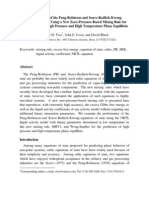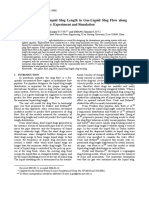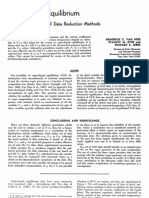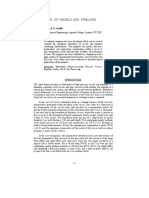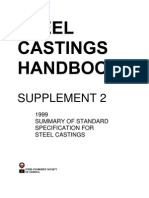0 ratings0% found this document useful (0 votes)
291 viewsEstimate Friction Factor Accuracy
Estimate Friction Factor Accuracy
Uploaded by
joatanmelo6775This document presents two new accurate equations (Eq. 2 and Eq. 3) for directly calculating the friction factor in fluid flows, without needing to do trial-and-error calculations or use a graph. Eq. 2 is derived from the Colebrook equation using Sieffenson's accelerated convergence technique, and is valid for transitional and turbulent flow at any relative roughness. Eq. 3 is a simpler version of Eq. 2 that is also nearly as accurate and easier to use for hand calculations. Both equations can determine the friction factor directly from the Reynolds number and relative roughness.
Copyright:
© All Rights Reserved
Available Formats
Download as PDF, TXT or read online from Scribd
Estimate Friction Factor Accuracy
Estimate Friction Factor Accuracy
Uploaded by
joatanmelo67750 ratings0% found this document useful (0 votes)
291 views2 pagesThis document presents two new accurate equations (Eq. 2 and Eq. 3) for directly calculating the friction factor in fluid flows, without needing to do trial-and-error calculations or use a graph. Eq. 2 is derived from the Colebrook equation using Sieffenson's accelerated convergence technique, and is valid for transitional and turbulent flow at any relative roughness. Eq. 3 is a simpler version of Eq. 2 that is also nearly as accurate and easier to use for hand calculations. Both equations can determine the friction factor directly from the Reynolds number and relative roughness.
Original Description:
Extracted from CHEMICAL ENÜINEERINC MARCH 5. 1984
Copyright
© © All Rights Reserved
Available Formats
PDF, TXT or read online from Scribd
Share this document
Did you find this document useful?
Is this content inappropriate?
This document presents two new accurate equations (Eq. 2 and Eq. 3) for directly calculating the friction factor in fluid flows, without needing to do trial-and-error calculations or use a graph. Eq. 2 is derived from the Colebrook equation using Sieffenson's accelerated convergence technique, and is valid for transitional and turbulent flow at any relative roughness. Eq. 3 is a simpler version of Eq. 2 that is also nearly as accurate and easier to use for hand calculations. Both equations can determine the friction factor directly from the Reynolds number and relative roughness.
Copyright:
© All Rights Reserved
Available Formats
Download as PDF, TXT or read online from Scribd
Download as pdf or txt
0 ratings0% found this document useful (0 votes)
291 views2 pagesEstimate Friction Factor Accuracy
Estimate Friction Factor Accuracy
Uploaded by
joatanmelo6775This document presents two new accurate equations (Eq. 2 and Eq. 3) for directly calculating the friction factor in fluid flows, without needing to do trial-and-error calculations or use a graph. Eq. 2 is derived from the Colebrook equation using Sieffenson's accelerated convergence technique, and is valid for transitional and turbulent flow at any relative roughness. Eq. 3 is a simpler version of Eq. 2 that is also nearly as accurate and easier to use for hand calculations. Both equations can determine the friction factor directly from the Reynolds number and relative roughness.
Copyright:
© All Rights Reserved
Available Formats
Download as PDF, TXT or read online from Scribd
Download as pdf or txt
You are on page 1of 2
BIBLIOTECA
* Estímate
; fiictíon factor
- accurately
^Here is a very accurate equation
^for calculating the friction factor
^directly, without trial-and-error.
A
^ T. K. Serghides, Kerr-McGee Chmical Corp.
The Colebrook equation is a widely used method for
^redicting/, the friction factor for fluid flow:* C= -2.0log(^ e/Z) ^2.51^^
3.7 Re
I ^=-2.0 1og(ff +1^) (.) Eq. 2 is derived by applying Sieffenson's accelerated-
convergence technique to an iterative, numerical solu
^here € is the absolute pipe roughness (ft), D is the tion of Eq. 1. The constants A, B and C are approxima
nternal diameler of the pipe (ft), and Re is the Reynolds tions of Eq. 1 obtained by three iterations of the
«•«umber for fiow. direct-substitution method. Eq. 2 is lhe approximation
You cannoi solve the Coiebrook equation directly, as obtained by combining those constants according to
le friction factor appears on both sides. To solve it Steffenson's formula.
-^equires trial-and-error or a graph—which are difficult to It happens that the numerical solution of Eq. I by this
f^rogram. Or you can use one of severa! approximate technique converges very fast, so Eq. 2 is very accurate—
^ílutions ihat are explicil in /, and lherefore can be i.e., it approximates Colebrook's equation wiihin a small
^olved directly. fraction of a percent.
This article presents two new approximations, based Henrici [Z] explains this behavior in discussing the
numerical solution of the Colebrook equation. Both bounds of error on a numerical solution after a finiie
^pear to be more accurate than any of the other pub- number of iterations. A previous article [2] discusses the
íhed approximations. conditions for convergence in solving the Colebrook
equation by direct substitution, and explains Steflfen-
. he friction-factor equations son's method.
This explicit friction-factor equation is valid for iransi- A simpler version of Eq. 2 is nearly as accurate, and
-^^nal and turbulent fiow {Re > 2,100) ai any relative perhaps easier to use for hand calculaiions. Like Eq. 2,
loughness (e/Z)): this equation is obtained by applying Sieffenson's
method to a numerical solution of Eq. 1. It is valid for
Re > 2,100 and any value of e/Z):
{A - 4.781)^ \-
Vre: ^ = _2.0 log M) / 781 -
B -2A + 4.781
(3)
where: A= -2.0 log 4-^ )
Noif ihiii ihc/usfd hcii- is ihc Darcv íactor. »vlth whkh Irictional head loss (A.
•^lav bc calciilaicdas A= l{IJl)){i''/-K)- Hci e. l. is k-iiKth (li), i' is vclociiv(fi/s).
g is the gravitaiional constam (fi/s*).
CHEMICAL ENÜINEERINC MARCH 5. 1984 63
You might also like
- Api 931 Chapter 6 Dispersion of Gases PDFDocument40 pagesApi 931 Chapter 6 Dispersion of Gases PDFArcangelo Di TanoNo ratings yet
- Fast and Accurate Approximations For The Colebrook Equation, Dag BibergDocument3 pagesFast and Accurate Approximations For The Colebrook Equation, Dag BibergDagNo ratings yet
- A Comparison of The Peng-Robinson and Soave-Redlich-Kwong Equations of StateDocument18 pagesA Comparison of The Peng-Robinson and Soave-Redlich-Kwong Equations of StateVettidog100% (1)
- 1987 - Multiphase Isenthalpic and Isentropic Flash Algorithms - MichelsenDocument15 pages1987 - Multiphase Isenthalpic and Isentropic Flash Algorithms - MichelsenhakeemniyasNo ratings yet
- Heat Exchanger Efficiency: Ahmad FakheriDocument9 pagesHeat Exchanger Efficiency: Ahmad Fakheridaud apriwaluyoNo ratings yet
- Smith Et al-1958-AIChE Journal PDFDocument3 pagesSmith Et al-1958-AIChE Journal PDFAlastairNo ratings yet
- A Review of Explicit Friction Factor EquationsDocument4 pagesA Review of Explicit Friction Factor EquationsRobinson MuñozNo ratings yet
- Explicit Reformulation of The Colebrook-White Equation For Turbulent Flow Friction Factor CalculationDocument8 pagesExplicit Reformulation of The Colebrook-White Equation For Turbulent Flow Friction Factor CalculationNurudin Habeed bin Mohd Abd Settar Faculty of Engineering & Life SciencesNo ratings yet
- Critical Properties Estimation From An Equation of StateDocument12 pagesCritical Properties Estimation From An Equation of StateAnayeli MedinaNo ratings yet
- Orifice Metering of Two Phase FlowDocument7 pagesOrifice Metering of Two Phase FlowMauricio Sanchez BernalNo ratings yet
- SPE 63158 Inflow Performance Relationships For Gas CondensatesDocument14 pagesSPE 63158 Inflow Performance Relationships For Gas Condensatesabnou_223943920No ratings yet
- Schulkes - Slug Frequencies Revisited PDFDocument15 pagesSchulkes - Slug Frequencies Revisited PDFneverwolfNo ratings yet
- Extension of Peng-Robinson For Complex MixturesDocument18 pagesExtension of Peng-Robinson For Complex MixturesMandy NelsonNo ratings yet
- Dukler 1980Document10 pagesDukler 1980Vassilios KelessidisNo ratings yet
- Modeling of Buried Natural Gas Pipeline Decompression: X. L. Zhou G. G. KingDocument8 pagesModeling of Buried Natural Gas Pipeline Decompression: X. L. Zhou G. G. Kingmatrix69No ratings yet
- A Theoretical Model To Predict Cavitation Inception in Centrifugal PumpsDocument13 pagesA Theoretical Model To Predict Cavitation Inception in Centrifugal Pumpsdodo1986No ratings yet
- Industrial & Engineering Chemistry Volume 28 Issue 12 1936 (Doi 10.1021/ie50324a027) Sieder, E. N. Tate, G. E. - Heat Transfer and Pressure Drop of Liquids in TubesDocument7 pagesIndustrial & Engineering Chemistry Volume 28 Issue 12 1936 (Doi 10.1021/ie50324a027) Sieder, E. N. Tate, G. E. - Heat Transfer and Pressure Drop of Liquids in Tubesrahulsaini855No ratings yet
- Calculation of Densities From Cubic Equations ofDocument5 pagesCalculation of Densities From Cubic Equations ofgermangsilvaNo ratings yet
- Pan, Hanratty - 2002 - Correlation of Entrainment For Annular Flow in Horizontal PipesDocument24 pagesPan, Hanratty - 2002 - Correlation of Entrainment For Annular Flow in Horizontal PipesJohn Doe100% (1)
- Flash Calculation Stability PDFDocument12 pagesFlash Calculation Stability PDFAndre BecNo ratings yet
- 456Document21 pages456David LapacaNo ratings yet
- BHR 2013 E5Document16 pagesBHR 2013 E5John DoeNo ratings yet
- Taitel Et. Al, 1990Document50 pagesTaitel Et. Al, 1990xowaf70826No ratings yet
- Calculation of Phase Envelopes and Critical Points For Multicomponent MixturesDocument10 pagesCalculation of Phase Envelopes and Critical Points For Multicomponent Mixturesflavio_cordero_1No ratings yet
- Improvement in Patel Teja Eqn of StatesDocument10 pagesImprovement in Patel Teja Eqn of StatesSumukh VermaNo ratings yet
- A New Vapor-Liquid-Asphaltene Three-Phase Equilibrium Computation Algorithm Based On The Free-Asphaltene AssumptionDocument14 pagesA New Vapor-Liquid-Asphaltene Three-Phase Equilibrium Computation Algorithm Based On The Free-Asphaltene AssumptionJorge Andres Rivera MoralesNo ratings yet
- SPE 131137 Steady-State Heat Transfer Models For Fully and Partially Buried PipelinesDocument27 pagesSPE 131137 Steady-State Heat Transfer Models For Fully and Partially Buried Pipelinesmostafa shahrabi100% (1)
- A New Generalized Alpha Function For A Cubic Equation of StateDocument11 pagesA New Generalized Alpha Function For A Cubic Equation of StateJenn QuintoNo ratings yet
- Churchill 1977Document7 pagesChurchill 1977LaviejafcNo ratings yet
- Bendik Sen 1991Document10 pagesBendik Sen 1991MaheshNo ratings yet
- Prediction of Temperature Drop Accompanying A Given Pressure Drop For Natural Gas WellstreamsDocument5 pagesPrediction of Temperature Drop Accompanying A Given Pressure Drop For Natural Gas Wellstreamsmisterno2No ratings yet
- Spe 6721 Pa PDFDocument7 pagesSpe 6721 Pa PDFkmilo04No ratings yet
- Development of Liquid Slug Length in Gas-Liquid Slug Flow Along Horizontal Pipeline: Experiment and SimulationDocument8 pagesDevelopment of Liquid Slug Length in Gas-Liquid Slug Flow Along Horizontal Pipeline: Experiment and SimulationAzizNo ratings yet
- Gomez Et Al 2000 Prediction of Slug Liquid Holdup PDFDocument5 pagesGomez Et Al 2000 Prediction of Slug Liquid Holdup PDFFrancisco OppsNo ratings yet
- A Model For Gas-Liquid Slug Flow in Horizontal and Near Horizontal TubesDocument11 pagesA Model For Gas-Liquid Slug Flow in Horizontal and Near Horizontal TubesEugene CommerellNo ratings yet
- OTC 24437 A Comprehensive Analysis On Gas-Liquid Slug Flows in Horizontal PipesDocument12 pagesOTC 24437 A Comprehensive Analysis On Gas-Liquid Slug Flows in Horizontal PipesbabyweiNo ratings yet
- Blowdown of Pipelines Carryng Flashing LiquidsDocument10 pagesBlowdown of Pipelines Carryng Flashing LiquidsMilson GomezNo ratings yet
- Beggs and Brill CorrelationDocument6 pagesBeggs and Brill CorrelationAli Al AkbarNo ratings yet
- Gregory Et Al PDFDocument7 pagesGregory Et Al PDFmostafa shahrabiNo ratings yet
- Mukherjee e Brill 1985 Empirical PDFDocument17 pagesMukherjee e Brill 1985 Empirical PDFFrancisco Opps100% (2)
- M25 GpsaDocument24 pagesM25 GpsaPawan ChaturvediNo ratings yet
- Two-Phase Flashing Flow Methods and Comparisons: J. C. Leung and F. N. NazarioDocument8 pagesTwo-Phase Flashing Flow Methods and Comparisons: J. C. Leung and F. N. NazarioAksheyNo ratings yet
- VLE, Part 1 - An Appraisal Od Data Reduction MethodsDocument7 pagesVLE, Part 1 - An Appraisal Od Data Reduction MethodsSamaneh HajipourNo ratings yet
- 03 Ernstsen Jensen Slug Force PresentationDocument26 pages03 Ernstsen Jensen Slug Force Presentationsam_kamali85No ratings yet
- Curtis Hays Whitson NTH PHD ThesisDocument360 pagesCurtis Hays Whitson NTH PHD ThesisLuis Alberto Izarra100% (1)
- Blowdown of Vessels and Pipelines: S.M. Richardson & G. SavilleDocument15 pagesBlowdown of Vessels and Pipelines: S.M. Richardson & G. SavillefaisalmuradNo ratings yet
- Hydrodynamic and Statistical Parameters of Slug Ow: Lev ShemerDocument11 pagesHydrodynamic and Statistical Parameters of Slug Ow: Lev ShemerAzizNo ratings yet
- Flash Calc 3Document16 pagesFlash Calc 3Mohamed MamdouhNo ratings yet
- A New Cubic Equation of State For Fluids and Fluid MixturesDocument11 pagesA New Cubic Equation of State For Fluids and Fluid MixturesBriam TicaNo ratings yet
- Gas-Liquid Flow in Slightly Inclined PipesDocument11 pagesGas-Liquid Flow in Slightly Inclined PipesBrenda DavisNo ratings yet
- Wong Sandler (1992)Document10 pagesWong Sandler (1992)Anonymous PO7VwbBnNo ratings yet
- Equivalent Diameter Is Not The Same As Hydraulic Diameter.: List of Hydraulic DiametersDocument5 pagesEquivalent Diameter Is Not The Same As Hydraulic Diameter.: List of Hydraulic DiametersRinnoNo ratings yet
- A MODIFIED PENG-ROBINSON EQUATION OF STATE FOR - ELV - 20519 - FTP PDFDocument12 pagesA MODIFIED PENG-ROBINSON EQUATION OF STATE FOR - ELV - 20519 - FTP PDFLuiz Roberto TerronNo ratings yet
- sympCA 82Document9 pagessympCA 82劉汯紳No ratings yet
- International Journal of Heat and Mass Transfer: Dejan BrkicDocument3 pagesInternational Journal of Heat and Mass Transfer: Dejan BrkicSagar DhuriNo ratings yet
- Research Notes: Boundary Element Method and Wave EquationDocument4 pagesResearch Notes: Boundary Element Method and Wave EquationKeith DixonNo ratings yet
- Hydrocarbon Saturation Equation According To The SB Conductivity ModelDocument7 pagesHydrocarbon Saturation Equation According To The SB Conductivity ModelAlejandroNo ratings yet
- An Exact Solution To The Colebrook EquationDocument1 pageAn Exact Solution To The Colebrook EquationJohnathan ConnectNo ratings yet
- 4442 Exam 2006Document7 pages4442 Exam 2006Roy VeseyNo ratings yet
- Mmta 0008 1893FDocument1 pageMmta 0008 1893Fjoatanmelo6775No ratings yet
- Steel Castings HandbookDocument58 pagesSteel Castings Handbookgalici2002100% (3)
- Steel Castings HandbookDocument58 pagesSteel Castings Handbookgalici2002100% (3)
- Book Chapter Refining of Chemical PulpDocument59 pagesBook Chapter Refining of Chemical Pulpjoatanmelo6775100% (1)
- Extreme Values and Saddle PointsDocument35 pagesExtreme Values and Saddle PointsGeorge SimmonsNo ratings yet
- Factoring Polynomials.: A A A A A Sa N N A ADocument6 pagesFactoring Polynomials.: A A A A A Sa N N A ALesther AlmadronesNo ratings yet
- Tval3 ThesisDocument92 pagesTval3 ThesisPhan TuNo ratings yet
- Assignment 1Document2 pagesAssignment 1Vibhanshu PrajapatiNo ratings yet
- Department of Construction EngineeringDocument18 pagesDepartment of Construction EngineeringNhan DoNo ratings yet
- A Fast Numerical Method For Flow Analysis and Blade Design in Centrifugal Pump ImpellersDocument6 pagesA Fast Numerical Method For Flow Analysis and Blade Design in Centrifugal Pump ImpellersCesar AudivethNo ratings yet
- Leclin 11Document42 pagesLeclin 11chotakamal3625No ratings yet
- Tutorials On Linear Programming Problems (Optimization) Last Date of Submission: 2066/03/23Document36 pagesTutorials On Linear Programming Problems (Optimization) Last Date of Submission: 2066/03/23Anonymous z3ihT9DJ1vNo ratings yet
- Lecture 5Document14 pagesLecture 5EdenNo ratings yet
- Eigen Values and Eigen Vectors Using Power MethodDocument5 pagesEigen Values and Eigen Vectors Using Power Methodajay_tinku_2No ratings yet
- LMDocument18 pagesLMLeonora C. FordNo ratings yet
- Day2 Polynomials CBQDocument5 pagesDay2 Polynomials CBQabidina7031No ratings yet
- Syllabi - Mathematics PDFDocument119 pagesSyllabi - Mathematics PDFNanda GopalNo ratings yet
- Matlab Fundamental 12Document11 pagesMatlab Fundamental 12duc anhNo ratings yet
- October 10, 2022 1 / 100Document105 pagesOctober 10, 2022 1 / 100Girik KhullarNo ratings yet
- ME STR Syllabus-R22-FinalDocument135 pagesME STR Syllabus-R22-FinalSwapnil KNo ratings yet
- Air ModelingDocument96 pagesAir ModelingBosko MiljevicNo ratings yet
- Chapter 01 (Error Analysis)Document11 pagesChapter 01 (Error Analysis)Imrul HasanNo ratings yet
- 15.093 Optimization MethodsDocument12 pages15.093 Optimization MethodsAnup scribdNo ratings yet
- Course Outline - Numerical MethodsDocument4 pagesCourse Outline - Numerical MethodsShahnewaz BhuiyanNo ratings yet
- Numerical Simulation of Friction Stir WeldingDocument6 pagesNumerical Simulation of Friction Stir WeldingJitender KunduNo ratings yet
- Solution of Equations and Eigenvalue ProblemsDocument18 pagesSolution of Equations and Eigenvalue ProblemsGovt.GraduateCollege TobaTekSinghNo ratings yet
- KubnaDocument5 pagesKubnawejnrooneyNo ratings yet
- MA 214 Lecture 12Document72 pagesMA 214 Lecture 12Harsh ShahNo ratings yet
- MT Integral NumerisDocument44 pagesMT Integral NumerisWardani PrimathikaNo ratings yet
- Nonlinear Programming Solution TechniquesDocument9 pagesNonlinear Programming Solution Techniquesprincesslove521_4165No ratings yet
- Module 6 Finding The Roots of Nonlinear Equations Using Iterative Methods Part 1-Of-2Document10 pagesModule 6 Finding The Roots of Nonlinear Equations Using Iterative Methods Part 1-Of-22022309114No ratings yet
- Lecture # 1-FEADocument15 pagesLecture # 1-FEABilal KhalidNo ratings yet
- Convergence CriteriaDocument9 pagesConvergence Criteriaajota_7No ratings yet
- The Concept of Stability in Numerical MathematicsDocument202 pagesThe Concept of Stability in Numerical MathematicsTomas Barrientos Bruna100% (1)


